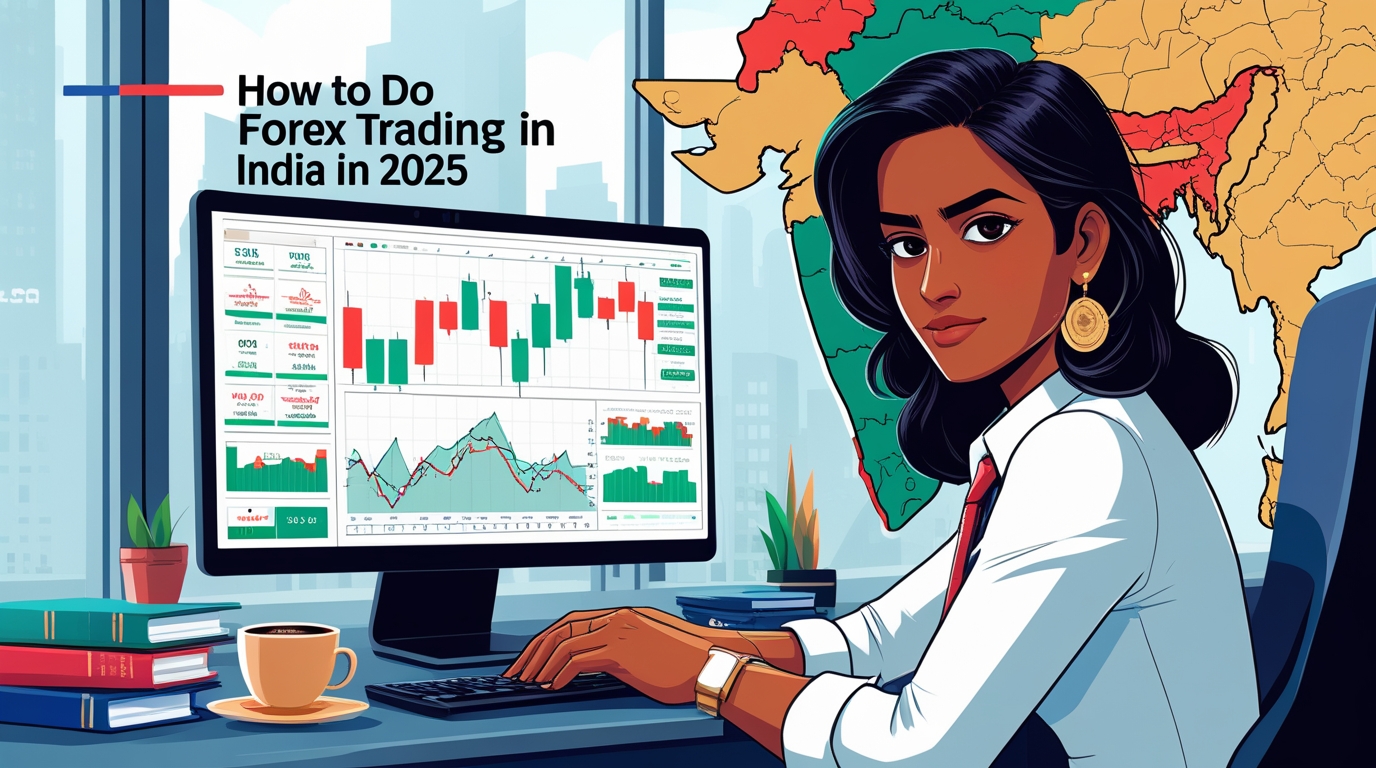
Forex trading – the exchange of currencies – has become increasingly popular among Indian investors. If you’re a beginner looking to learn how to do forex trading in India, it’s important to understand both the opportunities and the rules involved. The forex market is the largest financial market globally with a daily turnover of over $6 trillion, and the Indian rupee (INR) even ranks among the world’s top 20 traded currencies. This guide will walk you through how to start forex trading in India in 2025, covering the legal framework, choosing a broker, trading platforms, funding your account, and essential risk management tips – all in a slightly conversational yet professional tone.
Overview: Forex Trading in India in 2025
| Category | Key Details |
|---|---|
| Legal Status | Legal but strictly regulated by RBI and SEBI under FEMA. Must use authorized Indian brokers only. |
| Allowed Currency Pairs | INR pairs: USD/INR, EUR/INR, GBP/INR, JPY/INR Cross pairs: GBP/USD, EUR/USD, USD/JPY |
| Trading Instruments | Currency derivatives (futures and options) on NSE, BSE, and MSE exchanges. No spot forex trading |
| Trading Hours | INR pairs: 9:00 AM – 5:00 PM IST Cross-currency pairs: Till ~7:30 PM IST |
| Minimum Capital | ₹5,000-₹10,000 recommended to start. Margin per lot: ₹2,000-₹3,000 approximately |
| Top Brokers (2025) | Zerodha, Upstox, ICICI Direct, HDFC Securities, Angel One, Interactive Brokers India (all SEBI-registered) |
| Typical Brokerage | Flat ₹20 per trade (discount brokers) or percentage-based (full-service brokers) |
| Leverage | ~20x (varies by contract; SEBI-regulated margin requirements apply) |
| Account Requirements | Trading account with currency segment enabled. KYC: PAN card, Aadhaar, address proof, bank details. No demat required |
| Prohibited Activities | Cannot send money abroad for margin trading. No trading through unauthorized overseas platforms |
| Risk Management | Use stop-loss orders, risk max 1-2% per trade, limit total exposure to 6% of capital, start small with leverage |
| Taxation | Profits treated as business income or capital gains based on trading frequency. Taxed per income slab. Consult CA for specifics |
| Best for Beginners | Start with demo accounts, small trades (1 lot), educational resources, and practice platforms like Zerodha Kite or Upstox Pro |
| Market Size | Global forex market: $6+ trillion daily turnover. INR ranks in top 20 traded currencies worldwide |
| Key Success Factors | Education, discipline, risk management, emotional control, continuous learning, and patience |
How to Do Forex Trading in India Legally: RBI Rules & Regulations
Forex trading is legal in India but tightly regulated. The Reserve Bank of India (RBI) and the Securities and Exchange Board of India (SEBI) impose strict rules under the Foreign Exchange Management Act (FEMA). This means Indian residents can trade forex only through authorized channels and for permitted purposes. Attempting to trade through unregulated overseas brokers or unauthorized online platforms can lead to penalties under FEMA. Here are the key points of the legal framework:
- Authorized Brokers & Exchanges: You must use a broker or platform that is authorized by RBI and registered with SEBI. In practice, this means trading via SEBI-licensed Indian brokerages or RBI-authorized Electronic Trading Platforms (ETPs). Recognized Indian exchanges like the National Stock Exchange (NSE), Bombay Stock Exchange (BSE), and Metropolitan Stock Exchange (MSE) offer currency trading services that comply with regulations.
- Permitted Currency Pairs: India’s rules only allow trading currency pairs where INR is one side of the pair, with a few specific exceptions. In 2025, Indian retail traders can trade the Indian Rupee against major currencies – USD/INR, EUR/INR, GBP/INR, JPY/INR – as well as three cross-currency pairs among those majors (GBP/USD, EUR/USD, USD/JPY). No other foreign pair (like EUR/GBP or AUD/USD) is allowed for residents. Essentially, any forex trade you make must involve INR or be one of the RBI-approved major crosses.
- Currency Derivatives Only: Forex trading in India happens in the form of currency derivatives (futures and options) on exchanges, rather than spot forex trading. For example, you can trade USD/INR futures or options contracts on the NSE. All the permitted pairs have futures available, while options exist mainly for the INR-based pairs. This structure ensures transparency and regulatory oversight.
- No Overseas Margin Trading: A big point for beginners – you cannot send money abroad to trade on international forex platforms or margin trading websites. RBI’s Liberalized Remittance Scheme (LRS) explicitly bans remittances for margin trading or overseas forex speculation. So, stick to Indian platforms for legal forex trading.
- Compliance and Penalties: Always follow RBI guidelines on what purposes forex trading is allowed for (mostly investment or hedging). If a resident is found trading through unauthorized means or in prohibited instruments, they could face enforcement actions. The safest approach is to trade through a SEBI-regulated broker and adhere to the prescribed instruments and limits.
Quick Tip: Forex trading hours in India are not 24/5 like the global market – they align with exchange timings. The Indian currency market operates roughly from 9:00 AM to 5:00 PM IST for INR pairs, with cross-currency pairs trading a bit extended (till around 7:30 PM). Plan your trading schedule accordingly, since you cannot trade currencies round-the-clock through Indian exchanges.
How to Do Forex Trading in India: Step-by-Step Guide for Beginners
Now that you know the legal groundwork, let’s walk through how to start forex trading in India step by step. This section will help you go from a complete beginner to placing your first currency trade:

- Learn Forex Trading Basics: Begin by educating yourself on key forex concepts. Understand what currency pairs are and how exchange rates work. For instance, in a pair like EUR/INR, the first currency (EUR) is the base and the second (INR) is the quote; the price tells you how many rupees equal one euro. Learn basic terminology (pips, lots, leverage, etc.) and how forex markets function. Remember, the forex market is highly liquid and can be volatile, so a solid foundation is crucial before you risk any money.
- Ensure Legal Compliance: Before jumping in, make sure you will be trading through legal avenues. Plan to use a SEBI-registered broker and trade only the permitted currency pairs we listed above. Avoid any website or app that promises access to “all global forex pairs” or extremely high leverage outside of regulatory limits – those are red flags in India’s context. Sticking to the rules will keep your trading journey safe and worry-free.
- Choose a Reputable Forex Broker: Selecting the right broker is one of the most important steps. Look for an established Indian brokerage or a global broker with SEBI authorization. The broker should offer currency trading (often under “currency derivatives” segment). Ensure they have a good reputation, reliable customer support, and a user-friendly trading platform. Tip: Verify the broker’s SEBI registration number from their website footer and cross-check it on SEBI’s online register to be certain they’re authorized. We’ll discuss some of the best forex brokers in India in the next section.
- Open a Trading Account (KYC Process): Once you’ve picked a broker, you need to open a forex trading account with them. This usually involves: filling out an online application, submitting KYC documents (Know Your Customer – e.g. PAN card, Aadhaar, proof of address, bank details), and agreeing to the terms. The broker will verify your identity as per regulations. Account opening is often free or low-cost. Many brokers in India combine this with opening a demat account, but note that for currency trading, you don’t actually need to hold currencies in a demat – you just need a trading account with currency segment enabled. Complete all forms and verification steps; approval can take a couple of days if all documents are in order.
- Fund Your Trading Account: After your account is approved, you’ll need to deposit money into it as trading capital. Forex accounts in India are maintained in INR. Brokers provide various deposit methods like online bank transfer (NEFT/RTGS), UPI, or even cheques. Typically, there is no huge minimum deposit – you can start with as little as the margin required for one lot of currency futures (which could be a few thousand rupees). For example, some brokers may recommend a starting amount of ₹5,000–₹10,000 to comfortably cover margins. When you deposit, the funds will reflect in your trading account balance. This balance acts as margin for your forex trades (margin is essentially a security deposit with the broker for the leveraged positions you take). Always use a personal bank account to fund and withdraw, as per KYC.
- Download the Trading Platform: Most brokers offer a software or app for trading. Once your account is funded, download the broker’s trading platform – this could be a mobile app, web platform, or desktop software. Indian brokers often have their own platforms (like Zerodha’s Kite or ICICI Direct’s Trade Racer), and some support popular global platforms like MetaTrader 4/5 as well. Log in with the credentials provided by your broker. In the platform, add the currency pairs you plan to trade (e.g. USD/INR) to your market watch. Familiarize yourself with order placement (buying, selling, setting stop-loss, etc.) on the platform using small test orders or the broker’s demo account if available.
- Start with Small Trades (Practice and Learn): With everything set up, you’re ready to place your first trade. For beginners, it’s wise to start small. Use a demo trading mode if the broker offers one, or trade micro-lots/one lot to get a feel. In India, currency futures typically have fixed contract sizes (for example, 1 lot of USD/INR is usually $1,000), so know the contract value and the margin needed. When you place a trade, always set a stop-loss order to cap potential losses. Monitor your trades and see how the prices fluctuate. Expect some losses initially – that’s part of the learning curve. The goal at this stage is to gain experience, not to get rich quick.
- Learn and Implement Risk Management: As you begin trading, make risk management your top priority (we’ll dive deeper into this in a later section). A good rule of thumb is to never risk more than a small percentage of your capital on a single trade (many experts suggest 1-2%). Use tools like stop-loss orders diligently. Keep a trading journal of your trades and outcomes – noting what went right or wrong – so you can learn from each trade. This iterative learning will help you improve your strategy over time.
By following these steps, you’ll gradually build confidence in trading forex. Remember, forex trading for beginners is a marathon, not a sprint. Take time to refine your approach with each step. As you proceed, the next sections will give more insight into choosing brokers, using trading platforms, and managing risk effectively.
Choosing the Best Forex Broker & Platform in India

Selecting a forex broker in India is a crucial decision that can impact your trading success. Here’s what to consider and some top broker options for 2025:
- SEBI Registration: First and foremost, ensure the broker is registered with SEBI. This guarantees that the broker operates under Indian regulations and that your funds are somewhat protected by local laws. Brokers like Zerodha, Upstox, Angel One, ICICI Direct, HDFC Securities, and Interactive Brokers (India) are all SEBI-regulated and offer currency trading services. Using a regulated broker is non-negotiable for safety.
- Currency Pairs Offered: All Indian brokers will offer the four INR pairs (USD/INR, EUR/INR, GBP/INR, JPY/INR). Some, especially those with international access like Interactive Brokers, may also offer the permitted cross pairs (GBP/USD, EUR/USD, USD/JPY). However, the selection beyond these is not possible due to regulations. Check that the broker provides the specific pair you are interested in (e.g., not all brokers offered cross-currency trading initially, but by 2025 most do).
- Trading Platform & Tools: Evaluate the trading platform provided. For instance, Zerodha’s Kite and Upstox’s Pro Web are platforms known for user-friendly interfaces and good charting for beginners. Some brokers also support advanced platforms like MetaTrader or their own desktop software. If you prefer mobile trading, see if the broker’s app is well-rated and feature-rich. Features to look for include real-time quotes, interactive charts with technical indicators, a simple order entry system, and maybe a news feed or economic calendar.
- Costs and Fees: Lower costs can make a difference over time. Brokers in India generally charge either a small flat fee or a percentage per trade for currency futures. For example, Zerodha charges a flat ₹20 per executed order in the derivatives segment. Some brokers might even offer zero brokerage on currency trades up to a certain turnover as a promotional feature. Also be aware of any other charges: account opening fee, annual maintenance, withdrawal fee, etc. These are usually minimal with discount brokers.
- Leverage and Margin: SEBI defines the maximum leverage brokers can offer on currency derivatives (often around 20x; exact leverage depends on the contract’s margin requirement set by the exchange). Ensure the broker provides reasonable leverage and clearly informs you of the margin required per lot. Avoid brokers that claim to give extremely high leverage via dubious means – this ties back to staying within regulation.
- Customer Support: As a beginner, you’ll value responsive customer support. Check if the broker has support channels like phone, email, or live chat, and whether they are prompt in resolving issues. Also, see if they provide educational resources – some brokers have tutorials, webinars, or articles about forex trading which can be very helpful when you’re starting out.
- Demo Accounts: A demo or paper-trading account is great for practice. Not all Indian brokers have a demo mode for currency trading (since it’s exchange-based), but some do or they might allow a free trial period on their platform. If available, choose a broker that lets you practice with virtual money before you trade real money.
Popular Forex Brokers in India (2025): Here are a few reputable brokers and what they offer:
- Zerodha: India’s largest broker, known for its low-cost model. Offers USD/INR, EUR/INR, GBP/INR, JPY/INR futures (and options on these). No cross-currency pairs (except via INR), as Zerodha sticks to the strict interpretation of allowed pairs. Platform: Kite app/web, very beginner-friendly. Excellent educational content via Zerodha Varsity. Flat ₹20 per trade brokerage.
- Upstox: A popular discount broker. Provides access to INR pairs (futures/options) on its Upstox Pro platform. Competitive brokerage similar to Zerodha. Good trading app and charts, suitable for new traders.
- ICICI Direct / HDFC Securities: These are bank-backed full-service brokers. They offer currency trading (INR pairs, futures & options) integrated with your bank account, which is convenient for fund transfers. Their fees might be slightly higher (percentage-based brokerage), but they provide strong research reports and support.
- Interactive Brokers India: The Indian arm of IB (a global broker). IB is SEBI-registered and allows currency futures on Indian exchanges, but through its sophisticated Trader Workstation platform. It’s more feature-rich than most, with access to international markets as well. Suitable for advanced users or those planning to trade other global assets too.
- Saxo Bank / Fusion Markets / etc.: Some international brokers are sometimes mentioned on India lists. However, many of these do not have local authorization; they might serve clients remotely. Be cautious: trading with a foreign broker not registered in India can violate RBI rules. Unless they have a SEBI license, it’s safer to avoid them despite their tempting offers.
When choosing, weigh the pros and cons in light of your needs. A beginner might prioritize an easy interface and helpful support over ultra-low fees. On the other hand, if you plan to trade actively, saving on brokerage and having advanced chart tools might be key. Take your time to research and maybe even open a couple of accounts (most are free to open) to compare platforms.
Once you have your broker and platform sorted, you should be ready to trade. Before you dive in with real money, though, let’s talk about an extremely important aspect of forex trading: managing your risks.
Risk Management Strategies for Beginner Forex Traders
Forex trading offers profit potential, but it also carries significant risk – especially due to leverage (borrowing to amplify trades) and market volatility. As a new trader in India’s forex market, learning to manage risk is arguably more important than learning to pick winners. Here are some essential risk management strategies and tips:
- Start Small and Use Leverage Wisely: One advantage of forex is that you can control a large position with relatively small capital (thanks to leverage). However, leverage is a double-edged sword. While Indian brokers require margin (usually 3-5% of contract value) for currency futures, this still means you might be leveraging ~20 times your money. For beginners, consider using much less than the maximum leverage. It’s perfectly fine to trade one mini lot or one lot even if your account could technically handle more. Small positions ensure that even a big market swing won’t wipe you out.
- Set Stop-Loss Orders on Every Trade: A stop-loss is a preset order to automatically exit a trade if it goes against you beyond a certain point. This is a crucial tool to limit losses. Determine in advance the maximum you’re willing to lose on a trade (say, 0.5% or 1% of your capital) and set your stop accordingly. For example, if you bought USD/INR at ₹83.00 expecting it to rise, and you can only afford a ₹0.20 adverse move, you might place a stop at ₹82.80. Sticking to stop-losses prevents “hopeful holding” of losing positions.
- Manage Your Overall Exposure: Besides per-trade risk, keep an eye on your total market exposure. It’s easy to get carried away and open multiple trades that together put your account at high risk. A good rule is the 2%/6% rule some traders use – risk no more than 2% on any single trade and no more than 6% of your account on all open trades combined at any time. This ensures you live to trade another day even if a few trades go wrong in a row.
- Diversify (to a Point): In stock investing, diversification is key. In forex, the opportunities for diversification are limited for Indian traders (since only a handful of pairs are allowed). Still, avoid putting all your capital into one currency pair or one bet. You might, for instance, spread your trades across a couple of different pairs (maybe USD/INR and EUR/INR) if you see opportunities, rather than betting everything on one outcome. But don’t stray into pairs or products you don’t understand just to diversify.
- Keep Emotions in Check: Emotional trading is a silent account-killer. Fear and greed can cause you to deviate from your plan – like holding onto a losing trade hoping it turns around, or overleveraging to chase a big win. It’s important to stay disciplined. If you hit your daily loss limit, step away from the screen. If you catch yourself revenge-trading (trying to win back a loss immediately), take a break. Patience is a virtue in trading – sometimes the best action is to wait for a clear setup. As famed forex trader Bill Lipschutz once said: “If most traders would learn to sit on their hands 50 percent of the time, they would make a lot more money.”mitrade.com This highlights that not every moment is a trading moment – choose your trades wisely.
- Use Take-Profit and Trailing Stops: Just as important as cutting losses is protecting profits. When a trade moves in your favor, decide on a profit target or use a trailing stop (which moves your stop-loss up as price moves up, locking in gains). Greed can tempt you to let a winning trade ride forever, but markets can turn quickly. It’s often said, “No one went broke taking a profit.” So, secure partial profits if possible or trail your stop to ensure you bank something on winning trades.
- Continuous Learning and Adaptation: Risk management also involves learning from mistakes. Keep a journal of trades noting why you entered and how you felt. Review your big losses – did you ignore a stop? Trade during volatile news without understanding the risk? Make a note of it and adapt your rules to avoid repeating the same mistakes. Over time, your personal experience will become a guide for what not to do. Remember, every trader faces losses; what separates successful traders is how they manage and limit those losses. Legendary investor George Soros famously said, “It’s not whether you’re right or wrong that’s important, but how much money you make when you’re right and how much you lose when you’re wrong.” In essence, you can be wrong often and still come out ahead if your losses are small and wins are larger – that’s the magic of sound risk management.
By implementing these risk management practices, you’ll ensure that trading remains a sustainable endeavor for you. Risk management might not be the most exciting part of forex trading, but it’s certainly the most critical, especially for beginners. Protect your capital – you’ll need it to seize the real opportunities when they come!
Conclusion: Starting Your Forex Trading Journey in 2025
Forex trading in India in 2025 is accessible and legal, provided you play by the rules and prepare properly. As a beginner, you now know how to do forex trading in India – from understanding the regulatory do’s and don’ts, to picking a reputable broker, setting up your account, and making your first trades. We’ve also stressed the importance of risk management and patience in achieving long-term success in the forex markets.
In practice, the key advice is: start slow, stay informed, and keep improving. Begin with small trades and focus on learning rather than earning in the initial stages. Make use of demo accounts and educational resources offered by brokers or online platforms. Follow financial news, especially any RBI or SEBI updates, since regulatory changes can affect what and how you can trade. Gain some experience with how currency prices move – maybe the impact of a RBI interest rate decision on the USD/INR rate, or how global events influence the forex market.
It’s also worthwhile to connect with the trading community (there are many forums and groups for Indian traders) where you can ask questions and learn from others’ experiences. However, be cautious of “tips” or “gurus” promising guaranteed profits – there’s no such thing in forex or any market. Rely on building your own understanding and strategy.
Finally, maintain a balanced approach. Forex trading is just one form of investment – consider it as part of your overall financial plan. Never trade with money you can’t afford to lose; forex is not a get-rich-quick scheme, but with discipline, it can potentially yield good returns and also help hedge currency exposures if you have any international expenses or investments.
2025 is a great time to step into the world of currency trading. The tools are better than ever, information flows freely, and the Indian regulatory environment, while strict, provides a safe framework for retail traders. By following this guide and continuously educating yourself, you’ll be well on your way to navigating the forex market confidently.
Good luck on your trading journey, and remember – every expert was once a beginner. Stay patient, stay curious, and trade safe!
FAQs
Is forex trading legal in India?
Yes, forex trading is legal in India, but only under strict conditions. The RBI and SEBI regulate all forex trading. Individuals can trade only currency pairs that include the Indian rupee (such as USD/INR, EUR/INR, etc.), and a few specified cross-currency pairs, on authorized platforms. You must use a SEBI-registered Indian broker or exchange to trade. Trading through overseas or unregulated brokers is considered illegal for Indian residents. In short – it is legal if you follow RBI/SEBI rules and trade via official channels; otherwise, it is not.
Which currency pairs can I trade in India?
Indian retail traders are allowed to trade a limited number of currency pairs. The main ones are all pairs with INR on one side: USD/INR, EUR/INR, GBP/INR, and JPY/INR. In addition, regulators have also permitted three major cross-currency pairs: GBP/USD, EUR/USD, and USD/JPY. These can be traded on Indian exchanges in the form of futures (and options for the INR pairs). No other pairs (like AUD/USD or EUR/GBP, etc.) are legal for Indians to trade on domestic platforms. Always double-check with your broker which currency contracts they offer.
How much money do I need to start forex trading?
You do not need a huge amount to start forex trading in India – one of the benefits of forex is that it is accessible. You can begin with a few thousand rupees. Many brokers have no fixed minimum deposit, so even ₹5,000–₹10,000 is enough to get started. The important consideration is margin: for example, one lot of USD/INR might require around ₹2,000–₹3,000 margin (this can vary). Starting with ₹10,000 could allow you to take a couple of small positions with proper risk control. It is often recommended for beginners to start with an amount they are comfortable risking (even ₹1,000 or ₹2,000 is fine to learn the ropes), and treat early trades as learning experience. As you gain confidence, you can always add more funds. Remember, never trade with money you cannot afford to lose.
Do I need a demat account for forex trading?
No, a demat account is not required for trading forex/currency derivatives in India. Demat accounts are used to hold securities like stocks in electronic form. Forex trading in India is done via futures and options contracts, which are cash-settled and do not result in any physical delivery of currency that needs “dematerialization”. That said, when you open a trading account with an Indian broker, they might open a demat by default (especially if it is linked to equity trading). But to trade currency futures and options, you basically need a trading account with the currency segment enabled and a margin account for funds. So, focus on opening a trading account with a broker (who will take care of any demat formalities if needed).
How are forex trading profits taxed in India?
Profits from forex trading by individuals in India are generally treated as business income or capital gains, depending on frequency and intent. If you trade actively (like a trader), profits may be added to your income and taxed according to your income tax slab (as speculative business income). If you make only occasional trades as investments or for hedging, it might be treated as capital gains (though currency futures do not neatly fit capital gains like stocks do). Keep in mind that if you have losses, there are rules on how you can set them off against other income (speculative losses can only offset speculative gains, etc.). It is wise to consult a chartered accountant or tax professional about your specific situation. Maintain good records of your trades – contract notes, profit-loss statements – as you will need those for calculating taxable profit.

















